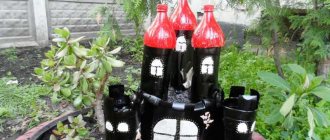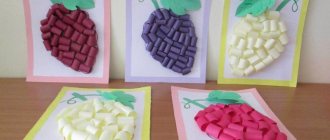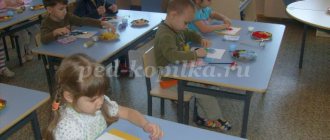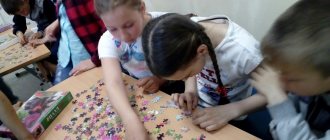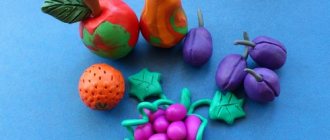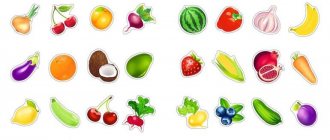Abstract of the GCD for modeling “Harvest in the garden” in the senior group
Victoria Vasilyeva Summary of the educational method for modeling “Harvest in the garden” in the senior group
Goal: to be able to convey the characteristic features of each vegetable in sculpting.
— Learn to create scenes with homogeneous objects, placing several figures on one stand;
— Learn to compare the shape of vegetables and fruits with geometric shapes;
— Enrich children’s speech with adjectives that characterize properties and qualities.
— To form the logical thinking of a preschooler through solving a problem situation;
— Develop the ability to sculpt familiar objects (vegetables) from life and from imagination, to depict their characteristic features.
— Cultivate the desire to complete the work started;
— Cultivate accuracy in work;
— Develop creativity, imagination, encourage creative discoveries and children’s desire to independently decide on an image;
— Cultivate interest in Russian folklore and riddles.
Preliminary work: examining subject pictures from the “Vegetables” series, coloring coloring books with vegetables, the didactic game “Wonderful Bag”, learning finger exercises.
Equipment: Envelope with a letter, plasticine, stacks, modeling boards, models of vegetables, teaching material on the topic “vegetables”.
(Knock on the door). The teacher brings an envelope with a letter.
- Look, they brought a letter from the forest from the Hare’s mother. They got into trouble. An evil Crow flew to their beds and took the entire harvest with it. Now Mama Hare will be left with her bunnies without tasty and healthy vegetables.
— They sent us a sad letter. Guys, do you think we can help the Hare?
(listen to the children's answers)
Educator: Guys, today I suggest you make a garden with a harvest for the bunnies. Let's take a closer look at vegetables. Children look at dummies and images of vegetables, the “Vegetable Garden” poster, specifying the features of their appearance (structure and coloring, shape of leaves, how vegetables grow in the garden bed)
Before we get to work, let's warm up a little.
One, two, three, four, (Walking in place)
Children learned vegetables: (Jumping in place)
Onion, radish, zucchini, (Tilts left and right)
Horseradish, carrots, garlic (Hand clapping)
Children are invited to the tables. There is plasticine and boards on the tables, the teacher explains the sequence of work.
Explanation and demonstration of the sequence and techniques of sculpting:
We make a ball from red plasticine. We make a flat cake from dark green plasticine. Cut out a star from the flatbread. We connect the details. We bend the leaves slightly upward. We sculpt a twig from dark green plasticine.
We make a ball from purple plasticine. Then we pull it out a little to make a droplet. We make a star from dark green plasticine, as for a tomato. Only fold the eggplant leaves down. Let's make a small branch.
To sculpt cabbage, prepare and knead green plasticine in your hands. Divide the prepared piece into small slices for sculpting cabbage leaves. Mash each slice in your hands, then press it on top with your fingers and stretch it to form thin oval-shaped cakes. Leave one part in the form of a ball. Make a ball with the center of the fruit, and stick leaves around it in the shape of a green rose.
To sculpt carrots you need green and orange plasticine. The fruits of this vegetable are oblong cone-shaped pieces that have pimples. To show them, use the stack again and pierce the soft plasticine in a random order. Make oblong leaves from green plasticine. Attach the leaves to the fruits.
We chop and chop the cabbage (swinging movements with our hands, like an ax
We knead the cabbage, knead the cabbage, (“knead the cabbage”)
We salt and salt the cabbage (“take” a pinch of salt and “salt”)
We press and press cabbage. (flexion and extension of the hands)
The teacher instructs each child to sculpt their own beds so that the garden is “rich.” The children choose a material and begin to sculpt while listening to calm music. As I work, I help children who have difficulty choosing sculpting methods.
Source
What you need for sculpting
As in previous lessons, we will first prepare a workplace: a table, oilcloth and plasticine. Cover the table with oilcloth. No matter how hard the child tries, at some point he will still want to roll the plasticine on the table. Therefore, you should not ignore modeling boards. It is worth protecting the baby’s sleeves from plasticine. If possible, put armbands on your baby.
If you have a mass for modeling, then you don’t need to worry about the plasticity of this material, but ordinary plasticine can be very dense. Therefore, we recommend warming up the plasticine a little. Just don’t put the pack on the battery!!!
Abstract of the GCD for modeling “Harvest in the garden” in the senior group
Victoria Vasilyeva
Abstract of the GCD for modeling “Harvest in the garden” in the senior group
Goal: to be able to convey the characteristic features of each vegetable in sculpting.
Tasks:
— Learn to create scenes with homogeneous objects, placing several figures on one stand;
— Learn to compare the shape of vegetables and fruits with geometric shapes;
— Enrich children’s speech with adjectives that characterize properties and qualities.
— To form the logical thinking of a preschooler through solving a problem situation;
— Develop the ability to sculpt familiar objects (vegetables) from life and from imagination, to depict their characteristic features.
— Cultivate the desire to complete the work started;
— Cultivate accuracy in work;
— Develop creativity, imagination, encourage creative discoveries and children’s desire to independently decide on an image;
— Cultivate interest in Russian folklore and riddles.
Preliminary work: examining subject pictures from the “Vegetables” series, coloring coloring books with vegetables, the didactic game “Wonderful Bag”, learning finger exercises.
Equipment: Envelope with a letter, plasticine, stacks, modeling boards, models of vegetables, teaching material on the topic “vegetables”.
Progress of the lesson:
Educator: Guys, autumn has come, time to harvest vegetables .
(Knock on the door). The teacher brings an envelope with a letter.
- Look, they brought a letter from the forest from the Hare’s mother. They got into trouble. An evil Crow flew to their beds and the entire harvest with it. Now Mama Hare will be left with her bunnies without tasty and healthy vegetables.
— They sent us a sad letter. Guys, do you think we can help the Hare?
(listen to the children's answers)
Educator: Guys, today I suggest you make a garden with a harvest for the bunnies. Let's take a closer look at vegetables. Children look at dummies and images of vegetables, the “Vegetable Garden” poster, specifying the features of their appearance (structure and coloring, shape of leaves, how vegetables grow in the garden bed)
Before we get to work, let's warm up a little.
Physical exercise "Vegetables"
One, two, three, four, (Walking in place)
Children learned vegetables: (Jumping in place)
Onion, radish, zucchini, (Tilts left and right)
Horseradish, carrots, garlic (Hand clapping)
Children are invited to the tables. There is plasticine and boards on the tables, the teacher explains the sequence of work.
Explanation and demonstration of the sequence and techniques of sculpting:
Making tomatoes:
We make a ball from red plasticine. We make a flat cake from dark green plasticine. Cut out a star from the flatbread. We connect the details. We bend the leaves slightly upward. We sculpt a twig from dark green plasticine.
Making the eggplant:
We make a ball from purple plasticine. Then we pull it out a little to make a droplet. We make a star from dark green plasticine, as for a tomato. Only fold the eggplant leaves down. Let's make a small branch.
Making cabbage:
To sculpt cabbage, prepare and knead green plasticine in your hands. Divide the prepared piece into small slices for sculpting cabbage leaves. Mash each slice in your hands, then press it on top with your fingers and stretch it to form thin oval-shaped cakes. Leave one part in the form of a ball. Make a ball with the center of the fruit, and stick leaves around it in the shape of a green rose.
Making carrots:
To sculpt carrots you need green and orange plasticine. The fruits of this vegetable are oblong cone-shaped pieces that have pimples. To show them, use the stack again and pierce the soft plasticine in a random order. Make oblong leaves from green plasticine. Attach the leaves to the fruits.
Finger gymnastics "Cabbage"
We chop and chop the cabbage (swinging movements with our hands, like an ax
We knead the cabbage, knead the cabbage, (“knead the cabbage”)
We salt and salt the cabbage (“take” a pinch of salt and “salt”)
We press and press cabbage. (flexion and extension of the hands)
The teacher instructs each child to sculpt their own beds so that the garden is “rich.” The children choose a material and begin to sculpt while listening to calm music. As I work, I help children who have difficulty choosing sculpting methods.
Source
VIDEO lesson - How to make Vegetables from plasticine
Vegetables from plasticine updated: April 30, 2022 by i7allia
Today let's make bright and beautiful vegetables from plasticine!
The theme of the gifts of nature and the harvest is one of the most favorite children's themes. Kids will have a lot of fun making cabbage, carrots, peas, broccoli, corn and pumpkin! We start each lesson by showing the children what a particular vegetable looks like in the picture.
How to make vegetables from plasticine? We'll start by making cabbage. Roll out a round ball from bright green plasticine. Then we cover the ball with flat cakes. The flatbreads are very easy to make. Roll into small balls and flatten them firmly between your fingers. We try to make the edges of the cakes a little wavy.
How to make cauliflower? Roll up a ball of yellow-white plasticine and make indentations in it. We wrap it with leaves around the edges. For cauliflower leaves we use different shades of green and yellow.
Let's start making carrots. We take orange plasticine and roll it into a “sausage”, applying a little more pressure on one side. We should end up with an elongated cone. Using a stack, we draw cuts on the cone. Decorate the carrots with greens and eyes.
When preparing each vegetable, we remember what can be prepared from it. Maybe a flavorful soup or a fresh salad?
To make the broccoli inflorescence look like a real one, roll up several light green stalks and the same number of dark green balls. We make pinholes in the balls. Glue a leg to each ball. We connect the legs with balls into a single “bouquet”. Complete the inflorescence with several yellow-green balls.
It's a little more difficult to make corn. We roll a sausage out of dark yellow plasticine and apply a checkered pattern onto it using a stack. Roll a small ball out of light yellow plasticine and press it into the top of the craft. From the same plasticine we make elongated leaves, which we use to wrap the bottom of the crafts. We try to bend the ends of the leaves naturally.
Probably the easiest way is to make a pumpkin from plasticine. Roll the pale orange plasticine into a ball. Let's make it a little flattened. Draw stripes on the sides in a stack. All that remains is to decorate the pumpkin with a green stalk and leaves.
Svetlana Ivanova
Summary of a modeling lesson in the middle group “Vegetables and Fruits”
Lesson summary for the middle group on the topic
“
Vegetables and Fruits ”
Modeling theme
: «
Vegetables and fruits
«
(middle group
)
Target :
Strengthen the ability to distinguish between vegetables and fruits
;
compose a story using reference pictures. Develop gross and fine motor skills. Foster a caring attitude towards nature. Develop memory, thinking, attention. Strengthen the ability to sculpt familiar round and oval objects using previously learned techniques (pulling, smoothing, pinching)
.
Demo material:
Pictures with vegetables and fruits
(tomato, onion, apple, pear, plum, lemon, orange, natural
vegetables and fruits (or dummies)
(tomato, onion, apple, pear, plum, lemon, orange,
“wonderful bag”
.
Handout :
Envelopes with two pictures depicting a vegetable and a fruit
(tomato and apple, carrot and pear, orange and tomato, plum and cucumber, cut into 2 parts vertically, plasticine, board, stack, napkins.
Summary of GCD for modeling in the senior group “Vegetables”
Gulperi Magomedova
Summary of GCD for modeling in the senior group “Vegetables”
sculpting techniques , rolling, stretching, pressing.
vegetables) from life , conveying their character and features;
2) Develop an eye;
3) Strengthen the skills of careful modeling (do not throw plasticine around, do not stain clothes)
4) Cultivate interest in Russian folklore and riddles.
Equipment: Plasticine, stacks, backing board, napkin, dummies of vegetables .
-show your child how to work with a piece of plasticine
-help the child with difficulty
On the topic: methodological developments, presentations and notes
Program objectives: to teach children to convey in sculpting the characteristic features of ducklings: an oval-shaped body and head, a wide beak and wide flat legs; lead to plot modeling through joint collaboration.
Goal: Consolidate children's knowledge of general concepts. Vegetables.
Summary of a modeling lesson in the middle group Topic “Duck” 1. Goal: to teach children to sculpt an object consisting of several parts, showing some characteristic features (elongated beak, tails.
Modeling from plasticine flagella “Snowdrop”. Goal: To teach how to make an applique from flagella. Tasks: To teach the method of modeling (plasticine applique), to improve the ability to roll out, etc.
State budgetary preschool educational institution kindergarten No. 81 of a general developmental type with priority implementation of activities for the cognitive and speech development of children in Vyborg paradise.
Source
